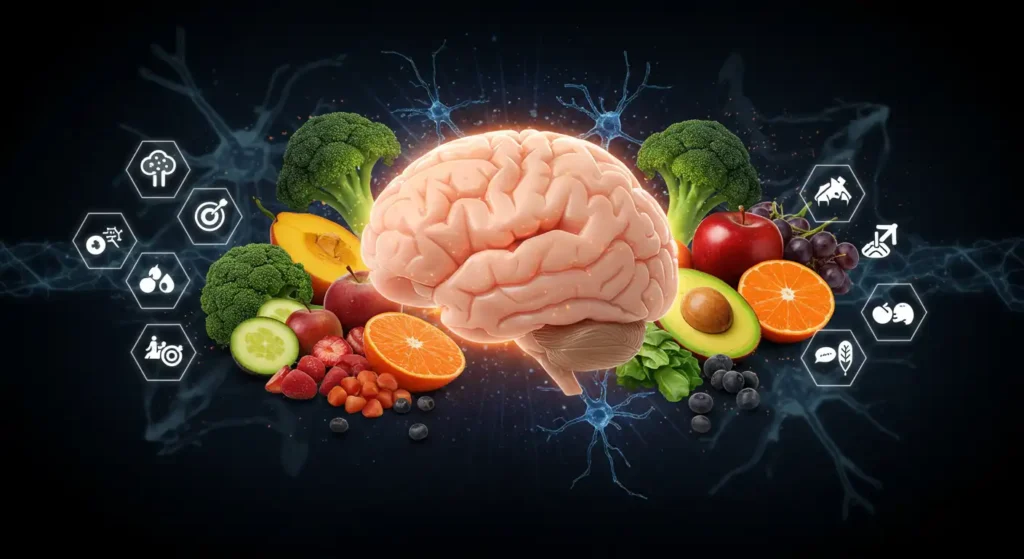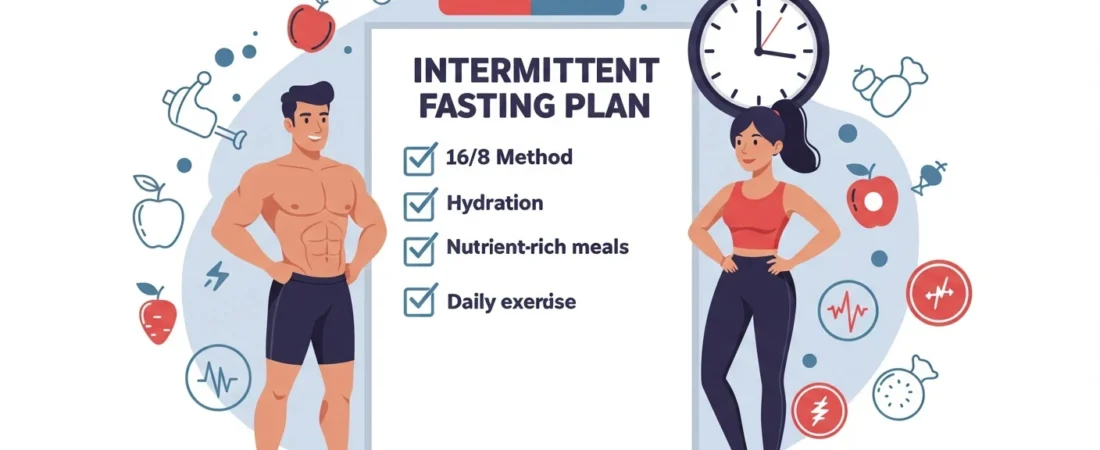Introduction
Starting a healthy lifestyle often feels overwhelming, especially when it comes to nutrition. Fortunately, intermittent fasting offers a science-based and easy-to-follow approach to weight loss and better foodhealth. Unlike traditional diets that restrict food types, intermittent fasting focuses on when you eat rather than what you eat. This flexible strategy can fit into nearly any routine, offering long-term sustainability, mental clarity, and metabolic benefits.
Intermittent fasting (IF) is more than a trend it’s backed by decades of scientific research and is practiced by millions seeking a natural way to optimize their health. According to Dr. Jason Fung, a renowned nephrologist and fasting advocate, “Intermittent fasting isn’t about starvation. It’s about training your body to burn fat more efficiently.”
What Is Intermittent Fasting? The Foundation of a Healthy Lifestyle
How Intermittent Fasting Supports a Healthy Lifestyle and Long-Term Weight Loss
Intermittent fasting (IF) has gained significant popularity in recent years, not just as a dietary trend but as a cornerstone of a truly healthy lifestyle. This approach to eating focuses less on what you eat and more on when you eat. It involves structured periods of eating followed by fasting, allowing the body to transition from using glucose to burning stored fat for energy. This metabolic shift not only supports effective weight loss, but also improves overall foodhealth and mental clarity.
There are several scientifically validated intermittent fasting methods that suit different lifestyles and preferences. The most popular ones include:
- 16/8 Method: Perhaps the simplest and most sustainable method, it involves a daily 16-hour fasting period followed by an 8-hour eating window. Most people skip breakfast and consume their meals between noon and 8 PM.
- 5:2 Diet: In this method, individuals eat normally five days per week and restrict calorie intake to about 500–600 calories on two non-consecutive days. This provides flexibility while still reaping the metabolic benefits of fasting.
- Alternate-Day Fasting (ADF): This more advanced method involves alternating between a day of regular eating and a day of either complete fasting or consuming a very small number of calories.
Each of these methods has been shown to offer unique health advantages. What they all have in common is their ability to encourage insulin sensitivity, reduce chronic inflammation, support hormonal balance, and boost the body’s natural fat-burning capacity. All of these are essential components of achieving better foodhealth.
Moreover, intermittent fasting works synergistically with the body’s circadian rhythms, which govern sleep-wake cycles and hormonal production. Aligning your eating pattern with natural light-dark cycles can optimize digestion, improve sleep quality, and promote better metabolic outcomes.
Beyond its physiological benefits
If can also foster mindful eating habits and reduce unnecessary snacking, helping people reconnect with their hunger cues. Over time, this promotes a more intentional and healthy relationship with food, an essential aspect of a balanced lifestyle.
“Fasting is not just an effective tool for weight loss. It also promotes cellular repair, reduces oxidative stress, and enhances brain function.” — Harvard Health Publishing
The benefits of intermittent fasting go far beyond the physical. Many practitioners report increased mental clarity, better mood stability, and a greater sense of self-discipline. These lifestyle improvements contribute to lasting behavioral change and overall wellness.
In conclusion, intermittent fasting is much more than a weight loss method it’s a sustainable health practice that supports metabolic health, cellular rejuvenation, and long-term vitality. Whether your goal is to manage weight, improve digestion, or simply live a more healthy lifestyle, intermittent fasting provides a powerful, evidence-based strategy.
How Intermittent Fasting Supports Weight Loss and a Healthy Lifestyle

The Science Behind Weight Loss, Fat Metabolism, and a Healthy Lifestyle
One of the primary motivations for adopting intermittent fasting is achieving sustainable and effective weight loss. Unlike traditional calorie-restriction diets that often lead to short-term results, intermittent fasting taps into the body’s natural metabolic mechanisms, making fat burning more efficient and long-lasting.
When you fast, insulin levels in the blood drop significantly. Since insulin is the hormone that signals the body to store fat, lower levels unlock the body’s ability to burn fat for energy. In addition, fasting increases the production of norepinephrine, a hormone that further boosts metabolic rate by stimulating fat breakdown. This hormonal environment is ideal for consistent and healthy fat loss.
Another powerful component of intermittent fasting is its ability to elevate human growth hormone (HGH) levels sometimes by as much as fivefold. This hormone is crucial for preserving lean muscle mass during weight loss, supporting fat metabolism, and accelerating recovery. Maintaining muscle mass during fat loss is essential for a healthy lifestyle, especially as we age.
“Intermittent fasting resulted in a weight loss of 3–8% over 3 to 24 weeks, which is a significant result compared to other methods.” — Varady, 2011
Furthermore, IF promotes metabolic flexibility, allowing the body to switch between burning glucose and fat as fuel with ease. This reduces fatigue, improves energy regulation, and supports a more balanced lifestyle.
Long-Term Foodhealth Benefits Beyond the Scale
While weight loss is a notable and often visible benefit, the real power of intermittent fasting lies in its long-term foodhealth impact. IF doesn’t just shrink your waistline it improves nearly every major system in your body.
Research has shown that intermittent fasting can:
- Lower blood pressure
- Improve lipid profiles, such as decreasing LDL cholesterol
- Reduce insulin resistance and stabilize blood sugar
- Lower systemic inflammation markers
- Decrease the risk of cardiovascular diseases
These changes contribute directly to a healthier heart, better blood circulation, and improved metabolic efficiency. Additionally, intermittent fasting positively affects gut microbiota, reducing bloating and enhancing nutrient absorption key components of digestive foodhealth.
From a cognitive perspective, fasting supports the production of brain-derived neurotrophic factor (BDNF), which enhances memory, focus, and brain function. Many practitioners report clearer thinking, reduced brain fog, and more consistent moods after integrating IF into their daily routine.
Moreover, fasting encourages better sleep quality by regulating melatonin and cortisol rhythms, both of which are vital for deep rest and recovery. With improved sleep, hormonal balance, and a stronger immune response, IF becomes more than just a diet it becomes a holistic lifestyle choice.
In summary, intermittent fasting is a multifaceted approach that not only fuels healthy weight loss but also improves your overall foodhealth, energy, and vitality. Its benefits span across physical, mental, and emotional health, making it one of the most effective strategies for long-term wellness.
Choosing the Best Intermittent Fasting Plan for Your Healthy Lifestyle and Foodhealth Goals

Adopting intermittent fasting as part of a healthy lifestyle can be transformative, but choosing the right fasting method is essential to long-term success. Not all intermittent fasting plans are the same each approach offers unique benefits depending on your weight loss goals, daily schedule, and foodhealth priorities.
Understanding your body, energy needs, and habits will help you select a plan that fits seamlessly into your lifestyle and promotes consistent, sustainable results.
16/8 Method – A Beginner-Friendly Intermittent Fasting Approach for Healthy Foodhealth
The 16/8 intermittent fasting method is one of the most popular and practical starting points for those new to fasting. This method involves a daily 16-hour fasting window followed by an 8-hour eating period. Most people choose to skip breakfast, begin eating around noon, and have their last meal by 8 PM.
What makes the 16/8 method particularly appealing is its simplicity. It requires no calorie counting and integrates smoothly into most routines ideal for professionals, parents, students, and anyone navigating a busy schedule. As such, it lays a solid foundation for building a healthy lifestyle.
To maximize benefits, it’s crucial to focus on nutrient-dense foods during the eating window. Meals should include:
- Lean proteins like chicken, tofu, eggs, or legumes
- Healthy fats such as avocado, olive oil, and nuts
- Complex carbohydrates like quinoa, brown rice, and vegetables
- Hydration, especially water and herbal teas
Pairing fasting with these smart food choices enhances metabolism, supports hormonal balance, and contributes to long-term foodhealth.
“Intermittent fasting, especially methods like 16/8, may be as effective as traditional calorie restriction in reducing body fat while preserving muscle mass.” — The New England Journal of Medicine (de Cabo & Mattson, 2019)
5:2 Diet – A Flexible Intermittent Fasting Plan for Weight Loss and Longevity
The 5:2 method offers a more flexible structure, perfect for those who prefer not to fast every day. It involves eating normally five days a week and reducing caloric intake to approximately 500–600 calories on two non-consecutive fasting days.
This plan is ideal for people seeking balance. It provides metabolic benefits while allowing room for social events, family meals, or variable work schedules. Beyond weight loss, the 5:2 method may enhance cognitive function, regulate blood sugar, and support longevity.
Emerging evidence suggests that intermittent calorie restriction, such as the 5:2 model, may even trigger autophagy, the body’s natural cell-cleaning process, which helps remove damaged cells and promotes overall cellular health.
Alternate-Day Fasting – An Advanced Intermittent Fasting Strategy for Deep Foodhealth Results
Alternate-day fasting (ADF) is a more advanced and intensive fasting protocol that alternates between fasting and eating days. On fasting days, individuals either consume no food or limit intake to about 25% of their regular calories. On eating days, meals are unrestricted but ideally nutrient-rich.
This method has been linked to:
- Rapid fat loss, especially visceral fat
- Improved insulin sensitivity and glucose regulation
- Reduced markers of chronic inflammation
While ADF can deliver profound foodhealth improvements, it’s not for everyone. Because of its intensity, beginners or individuals with certain medical conditions should approach this method cautiously and ideally under professional supervision from a nutritionist or healthcare provider.
This plan is best suited for highly motivated individuals with a structured lifestyle and clear health goals.
Intermittent Fasting for Mental Health and Longevity: A Path to a Healthy Lifestyle and Sustainable Foodhealth

While many embrace intermittent fasting for weight loss, its true value extends far beyond the scale. Emerging research reveals how fasting contributes significantly to mental health and longevity, reinforcing its role in a truly healthy lifestyle. By improving brain function and cellular regeneration, fasting serves as a cornerstone of long-term foodhealth and vitality.
Boosting Brain Function with a Healthy Fasting Routine for Cognitive Wellness
In today’s overstimulated and fast-paced world, maintaining mental clarity is more important than ever. Fortunately, intermittent fasting acts as a natural nootropic—sharpening focus, improving memory, and enhancing overall cognitive performance.
During fasting periods, the body produces higher levels of brain-derived neurotrophic factor (BDNF). This vital protein supports the growth of new neurons, enhances neuroplasticity, and protects against age-related cognitive decline. According to a study published in Nature Reviews Neuroscience, increased BDNF levels are directly associated with improved memory, learning, and mental resilience (Mattson, 2008).
Moreover, intermittent fasting helps regulate dopamine and serotonin levels key neurotransmitters involved in mood regulation. As a result, many individuals report:
- Reduced brain fog
- Improved mental focus
- Fewer mood swings and anxiety
- Greater emotional balance
This makes intermittent fasting a powerful tool not just for physical health, but also for navigating modern life with clarity and calm.
“Fasting may delay the onset of neurological disorders and improve outcomes by enhancing brain function, neuroplasticity, and resistance to stress.” — National Institute on Aging
Slowing Aging and Enhancing Longevity Through Smart Foodhealth Habits
Fasting doesn’t just preserve your mind it may also extend your lifespan. One of the most profound effects of intermittent fasting is the stimulation of autophagy, a process by which cells break down and remove damaged components. This self-cleaning mechanism supports tissue repair, reduces oxidative stress, and lowers the risk of age-related diseases.
Autophagy has been linked to:
- Reduced risk of Alzheimer’s and Parkinson’s
- Protection against cancerous cell mutations
- Slowed cellular aging and enhanced mitochondrial health
In fact, a 2020 study published in Cell Metabolism showed that intermittent fasting enhanced metabolic flexibility and longevity markers in both animal and human models (Patterson & Sears, 2020).
Additionally, fasting may contribute to hormonal balance, immune system rejuvenation, and reduced inflammation three key components of living a long, energetic life. As more people look for natural strategies to age gracefully, intermittent fasting stands out as an evidence-based method to align foodhealth, brain vitality, and overall well-being.
With each fasted state, your body isn’t just burning fat it’s rebuilding itself for a longer, healthier journey ahead.
Starting Intermittent Fasting Safely and Successfully: Your Guide to a Healthy Lifestyle Transformation

Intermittent fasting is a powerful tool for achieving weight loss and fostering a healthy lifestyle. However, like any lifestyle change, it’s essential to start it in a safe and manageable way to ensure long-term success and wellness. This section provides you with a step-by-step guide to help you begin your intermittent fasting journey and make it sustainable, while also addressing common challenges and solutions.
Step-by-Step Guide to Begin Your Intermittent Fasting Journey
To maximize the benefits of intermittent fasting, it’s crucial to take a gradual and thoughtful approach. Here’s how you can begin:
1. Choose a Method That Fits Your Schedule and Lifestyle
Start by selecting a fasting method that aligns with your day-to-day routine and preferences. Whether it’s the popular 16/8 method, the more flexible 5:2 diet, or alternate-day fasting, choosing the right method is essential for making it work in the long run.
2. Start Slowly with Smaller Fasting Windows (12/12) Before Transitioning to Longer Ones
If you’re new to fasting, consider starting with a more manageable 12/12 fasting window. This involves fasting for 12 hours and eating within a 12-hour window. Over time, you can gradually extend the fasting period to 16 hours or more, depending on your comfort level.
3. Stay Hydrated and Consume Electrolytes During Fasting Windows
Staying hydrated is key during fasting periods. Drink plenty of water and consider adding electrolytes (sodium, potassium, magnesium) to support hydration and prevent muscle cramps. Herbal teas can also be an excellent choice to keep you energized without breaking your fast.
4. Plan Meals with Nutrient-Rich Whole Foods
When it’s time to eat, focus on nutrient-dense whole foods to fuel your body. Prioritize lean proteins, healthy fats, complex carbohydrates, and plenty of fruits and vegetables. These foods will help keep you satisfied, boost your energy, and support your foodhealth goals.
5. Listen to Your Body and Adjust Based on Energy Levels and Mood
One of the most important aspects of intermittent fasting is tuning into your body. If you feel fatigued or experience mood swings, adjust your fasting window or meal timing. It’s essential to honor your body’s signals and make adjustments as needed to ensure a positive experience.
Common Challenges and How to Overcome Them
Although intermittent fasting is generally safe, it may present some challenges, especially in the beginning. Here are some common hurdles and strategies to help you overcome them:
Hunger Pangs
Hunger is one of the most common challenges when starting intermittent fasting, but it’s often manageable. To reduce hunger, keep yourself busy during fasting periods, drink plenty of water or herbal teas, and consider drinking black coffee if it fits your fasting plan.
Low Energy
During the initial stages of fasting, some people may experience low energy levels. To combat this, ensure you’re getting enough sleep and consider increasing your intake of micronutrients (vitamins and minerals) to support your body’s energy needs. Focus on eating nutrient-rich foods during eating windows to help maintain optimal energy levels.
Social Situations
Navigating social situations, especially meals with friends or family, can be challenging when following a fasting schedule. To stay flexible and avoid stress, plan your fasting and eating windows around social events. If necessary, adjust your fasting period for the day, or choose lighter options that fit within your eating window.
Intermittent Fasting Myths That Hurt Your Healthy Lifestyle: Debunking Common Misconceptions

Intermittent fasting (IF) has gained significant popularity in recent years as a powerful tool for weight loss, improving foodhealth, and promoting a healthy lifestyle. However, as with any trending health practice, there are numerous myths and misconceptions surrounding it. These myths can prevent individuals from reaping the full benefits of intermittent fasting and may even lead to unhealthy habits. In this section, we’ll debunk some of the most common myths to help you separate fact from fiction and embrace a healthier way of eating.
Myth 1 – Fasting Slows Your Metabolism
A common myth surrounding intermittent fasting is the belief that it slows down your metabolism, leading to fewer calories burned. In reality, intermittent fasting can boost metabolism in the short term, making your body more efficient at burning fat. Studies have shown that during fasting periods, metabolism can increase by up to 14%, enhancing fat breakdown and improving overall metabolic health (Tinsley, 2016).
While extended calorie restriction can have negative effects on metabolism, intermittent fasting is different. It allows your body to adjust to periods of rest and recovery while still promoting fat burning, providing significant benefits without the risks of long-term caloric deprivation.
Myth 2 – Fasting Equals Starvation
Another pervasive myth is that intermittent fasting is equivalent to starvation. Many people assume that fasting deprives the body of essential nutrients and energy. However, this is not the case. Fasting is a controlled and intentional process that encourages your body to use stored energy more efficiently. Rather than starving the body, intermittent fasting helps to optimize the use of glucose and fat stores for fuel, without depriving you of the nutrients you need.
In fact, intermittent fasting allows your body to enter a state of autophagy, where it cleans out damaged cells and regenerates new ones. This process supports cellular repair, promotes longevity, and reduces the risk of chronic diseases benefits that go far beyond simple weight loss.
Myth 3 – Fasting Causes Muscle Loss
A major concern for those considering intermittent fasting is the fear of losing muscle mass. However, studies show the opposite effect. When practiced correctly, intermittent fasting can actually preserve muscle mass, especially when combined with strength training and sufficient protein intake during eating windows.
Human growth hormone (HGH) production, which is naturally boosted during fasting periods, plays a crucial role in muscle preservation and fat metabolism. By maintaining proper nutrition and strength training, you can avoid muscle loss while effectively burning fat, making intermittent fasting a useful tool for both weight loss and muscle retention.
Intermittent Fasting Combined with Exercise for Maximum Weight Loss and Foodhealth

Combining intermittent fasting with regular exercise is one of the most effective strategies for achieving sustainable weight loss, enhancing foodhealth, and cultivating a healthy lifestyle. While both fasting and working out independently offer health benefits, their synergy can accelerate fat loss, improve energy levels, and boost overall wellness. However, understanding how to pair them properly is key to avoiding fatigue, muscle loss, or nutritional imbalances.
Best Practices for Working Out While Fasting to Boost Weight Loss
Many fitness enthusiasts wonder whether they can exercise during fasting periods without negatively affecting performance or health. The answer is yes but with a few guidelines.
Engaging in light cardio such as walking, cycling, or yoga during fasting windows can increase fat oxidation since the body has lower insulin levels and is more likely to tap into stored fat for energy. Likewise, low to moderate-intensity strength training can be effective during a fast, particularly for individuals adapted to this routine.
However, it’s important to listen to your body. If you’re new to intermittent fasting, your energy levels may dip during the initial weeks. In this case, scheduling more intense workouts (such as HIIT or heavy lifting) after breaking your fast ensures that your body has the fuel it needs to perform optimally.
“Exercising while fasting triggers different metabolic pathways, encouraging the body to burn fat for fuel more efficiently.” — Journal of the International Society of Sports Nutrition, 2014
Additionally, staying well-hydrated before and after your workouts is essential to prevent cramps and fatigue—especially when fasting.
H3: Fueling Recovery for a Healthy Lifestyle and Sustained Energy
Once your workout is complete, how you refuel plays a crucial role in recovery and in maintaining a healthy lifestyle. Post-workout meals should be rich in lean protein, healthy carbohydrates, and good fats. Protein supports muscle repair and growth, while carbs replenish glycogen stores and fats help balance hormones.
Here’s an example of a balanced post-workout intermittent fasting meal:
- Grilled chicken or tofu
- Quinoa or sweet potato
- Avocado or olive oil-based dressing
- A side of mixed leafy greens
- A protein smoothie with berries and almond milk
Including electrolytes, such as magnesium and potassium, can also support recovery especially if you’re fasting for longer durations or working out in the heat.
To maximize both fat loss and performance, consider timing your eating window to coincide with your workout schedule. For example, using the 16/8 method, you might train at 11 AM and break your fast at noon with a nutrient-rich post-workout meal. This timing aligns with your body’s natural rhythm and optimizes nutrient absorption.
Ultimately, the key to combining intermittent fasting and exercise is balance. With proper planning, this powerful duo can significantly enhance weight loss, foodhealth, and mental clarity without sacrificing muscle or energy.
Who Should Avoid Intermittent Fasting? Foodhealth Safety Tips for a Healthy Lifestyle

While intermittent fasting has gained widespread popularity for supporting weight loss, enhancing foodhealth, and promoting a healthy lifestyle, it’s not suitable for everyone. Despite its numerous benefits, fasting may pose risks for certain individuals or under specific health conditions. Therefore, it’s essential to understand who should approach this practice with caution or avoid it altogether.
Medical Conditions That May Conflict with Intermittent Fasting and Foodhealth
For individuals managing specific medical conditions, intermittent fasting may interfere with treatment plans, nutrient absorption, or energy regulation. Below are a few health concerns where IF should be reconsidered or monitored closely:
- Diabetes (especially Type 1 or insulin-dependent Type 2): Fasting can significantly affect blood glucose levels. Skipping meals may result in hypoglycemia (low blood sugar) or dangerous fluctuations, especially when combined with glucose-lowering medications. Always consult an endocrinologist before trying any fasting protocol.
- Eating disorders (anorexia, bulimia, binge eating disorder): For people recovering from or at risk of disordered eating, intermittent fasting can act as a trigger. The restrictive nature of fasting windows may reinforce unhealthy habits and negatively impact mental and foodhealth.
- Chronic low blood pressure or adrenal fatigue: Long fasting periods may exacerbate symptoms like dizziness, weakness, and fatigue. These individuals may benefit more from a balanced eating plan that stabilizes energy throughout the day.
- Thyroid issues: While research is ongoing, there are concerns that extended fasting may negatively impact thyroid hormone levels, particularly in women.
When in doubt, it’s always wise to speak with a healthcare provider or registered dietitian before incorporating fasting into your daily routine.
Special Populations and Healthy Lifestyle Alternatives to Intermittent Fasting
Beyond medical conditions, there are specific groups for whom intermittent fasting may not be the most healthy lifestyle choice. These populations may have unique nutritional requirements that make prolonged fasting unsafe or ineffective:
- Pregnant and breastfeeding women: These life stages require increased caloric and nutrient intake to support fetal development and milk production. Fasting can compromise both maternal and infant health.
- Children and adolescents: Young individuals are in critical stages of growth, brain development, and hormone regulation. Regular, balanced meals rich in essential nutrients are far more beneficial than any form of fasting.
- Elderly individuals: Aging bodies process nutrients differently, and fasting may increase the risk of nutrient deficiencies, falls, and muscle loss (sarcopenia). Seniors may benefit more from smaller, more frequent meals tailored to their metabolic needs.
For these groups, healthy eating routines emphasizing whole foods, regular meal timing, and portion control may be safer and equally effective for promoting foodhealth, energy, and well-being.
Conclusion: Embrace Intermittent Fasting as Your Key to a Healthy Lifestyle
Whether you’re aiming for weight loss, improved mental clarity, or overall foodhealth, intermittent fasting provides a sustainable, flexible, and science-backed method to help you succeed. It’s not just a diet it’s a way of life that can transform how you think, eat, and live.






